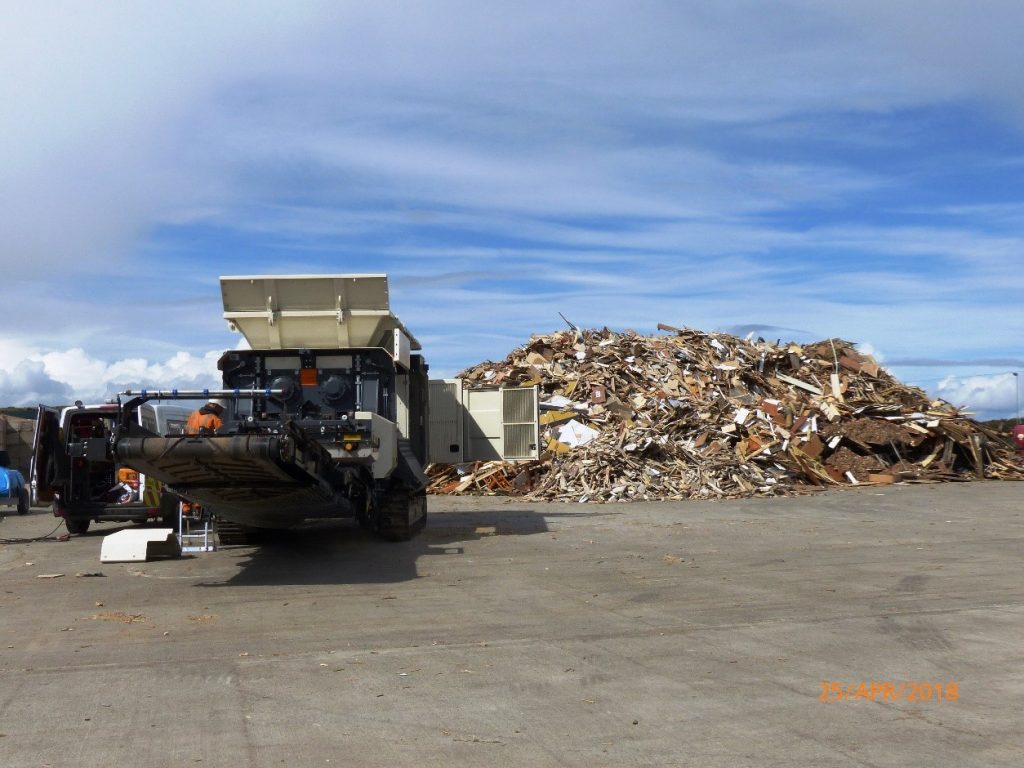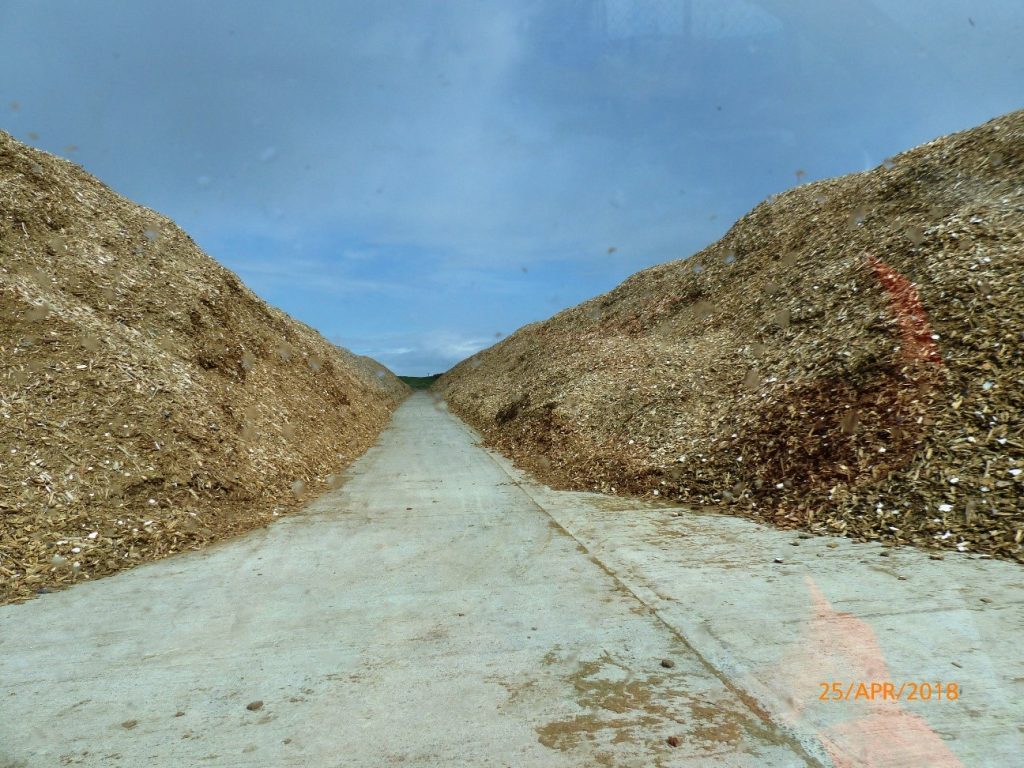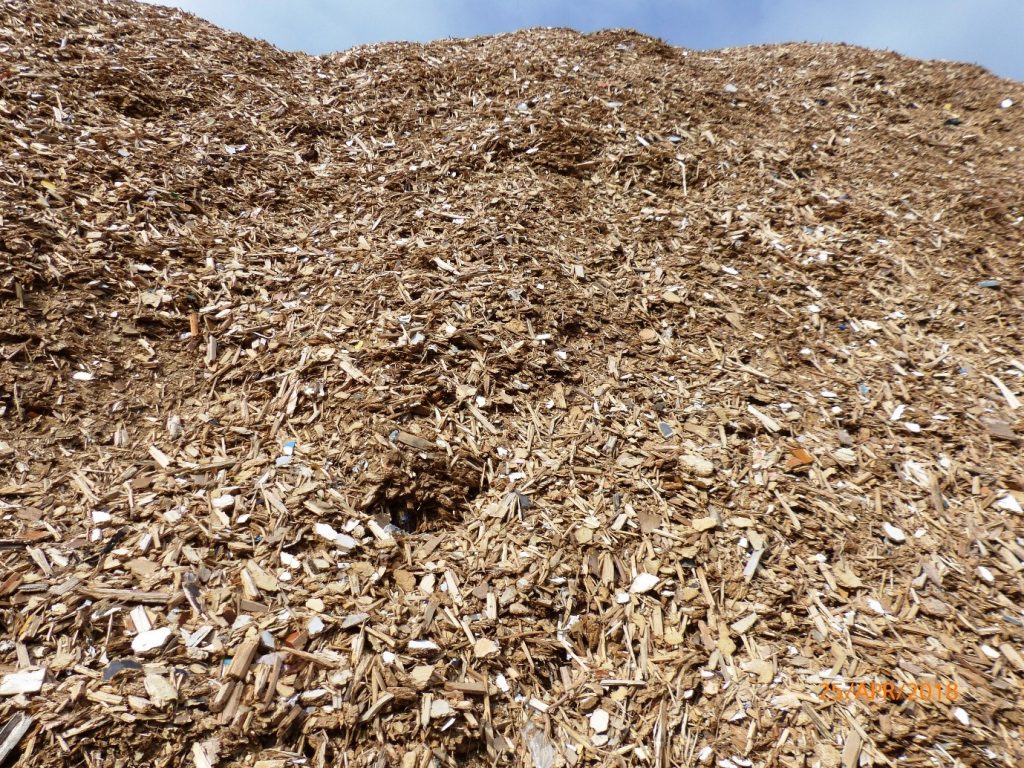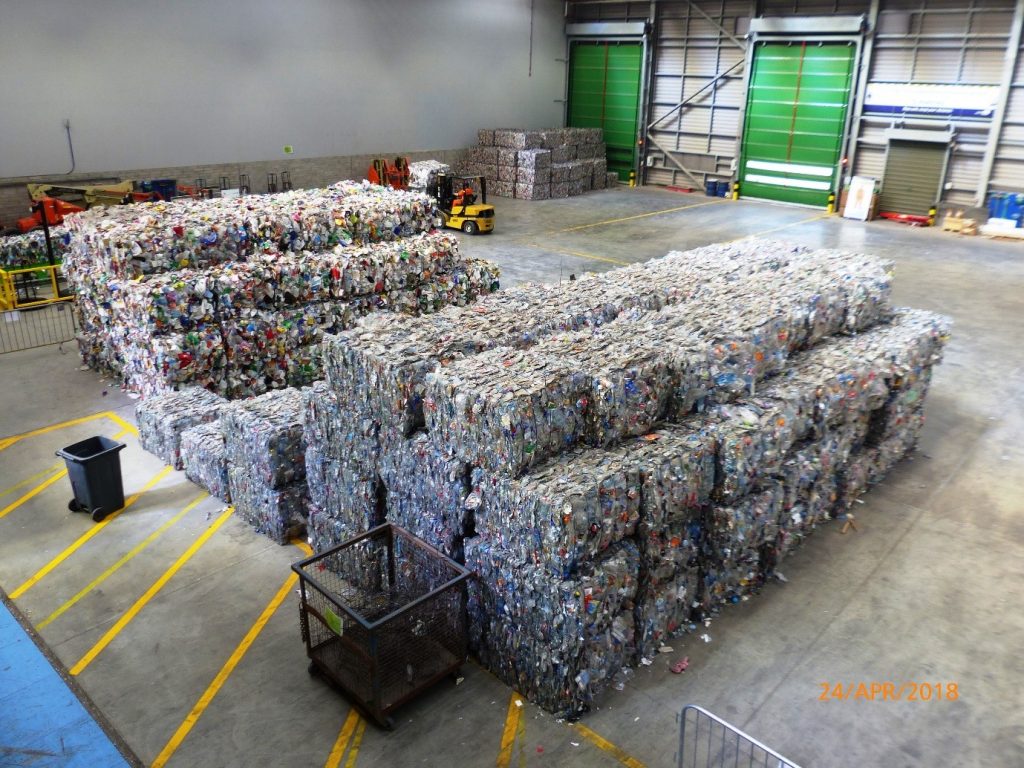SUEZ site-seeing | Part 16 | Binn Farm Landfill, Wood Waste Recovery and Materials Recycling Facility
29th August 2018
After the three hour journey down from Inverness I arrive at Binn Farm where I am keen to see how the processes work here, and how they differ to the site in Aberdeen that I visited yesterday.
Stop four | Binn Farm landfill and material recycling facility

Mixed wood waiting to be shredded at Binn Farm
The last stop of the day, on route to Edinburgh Airport was at Binn Farm, which sits on the Binn Agricultural Estate where we have a landfill site which has been closed for the last four years, but which is still being capped (as it is being returning it to agricultural use), and where gas extraction is expected to continue for several more years. The landfill gas extraction generates 3.5MW per year of electricity, which goes back into the National Grid.
The site also has an operational materials recycling facility (MRF), which is located in a repurposed cowshed, who said we can’t recycle! The MRF was originally developed to take Perth and Kinross’ commingled recyclables from 2010 to July 2017. In November 2017 there was a request from Highlands Council to help improve recycling levels and sort their commingled loads, when the site was redeveloped.
This site is not like any of our MRFs, because of the repurposed building and scale of the operation, only dealing with 11,000 tonnes per annum. It focuses on manual sorting rather than automated systems (very different from the previous day in Aberdeen). The ongoing market concerns about quality and contamination has required the plant to deliver a higher specification output (particularly on paper and fibre). To achieve this the process was slowed down (to 80% of target throughput) and the manual sorting primarily focuses on cleaning up the paper loads, enabling automated sorting of the plastics and metals. The plant operates at three tonnes per hour, unlike the 14 or 15 tonnes per hour achieved throughout our automated sites, but it makes sense in this location and these circumstances.
The mixed input commingled feed is fed across a trommel (a large rotating machine) to split into smaller (bottles, cans etc.) and larger (paper) fractions. The two streams then go via separate (but parallel) picking belts for manual sorting, plus eddy current and over band magnets on each line to remove metals. The paper fines are separated from the other fines using a fan system (known as density separation) and then added back into the paper product at the end. The best grade paper goes un-compacted and baled to Shotton Paper Mill in 25 tonne loads, to meet their demands, whilst the lower grade paper goes to SAICA.
Stop five | Wood waste recovery

Two windrows of wood chip on site
The final activity on site was the Wood Reprocessing Pad, which is on part of the reclaimed landfill site. This is one of our four sites in UK supplying wood chip to the RWE Group as a feedstock for their bio-power plant, which is only 30 minute drive from this site.
I have already seen wood reclamation at Packington and Clifton Marsh (Lancashire) but Binn Farm is unique in that it is also a stock holding site for the client, holding up to 20,000 tonnes of wood chip during planned outages at the biomass facility (usually a three week period). During power plant maintenance periods our other sites send their chip to Binn Farm for storage on the 7.5 acre concrete pad, where windrows of wood chip are created each containing 3,500 tonnes of woodchip! Clearly fire risk is a concern, as the material is volatile due to its organic content and moisture levels, so we use probes in the windrows which feed wireless temperature readings every 15 minutes back to a central computer. The first alarm (be aware alert) is raised at 55 degrees centigrade, whilst a level two warning happens at 75 degrees centigrade (this is when we need to act!). There is no compaction of the material as this would increase the fire risk, there are very few hot spots to be dealt with due to the lessons learned over years of operation and monitoring. When there is a level two alert, one the team quickly dig out the hot spot area and put out any fires.
Wood from the region is delivered to site where it is shredded using new TERREX equipment. As with our other sites this allows for an initial shred (larger size) followed by metals extraction through over band magnets on the conveyors. Following this, the material then goes through a second finer shred of the wood chip, then onto the screener where additional metals separation via an eddy current separator happens. The material is then moved into one of the windrows. Waiting for RWE to put in their next order, usually daily apart from the maintenance periods.

High grade wood chip waiting to go to RWE biomass plant
This site is constantly involved in R&D trials with customers and the wider industry to test the suitability of different agricultural residues as a feedstock for RWE. We are also part of some trials to test the different properties of older aged wood compared to newer shredded woodchip at the biomass plant. We help to blend the target feedstocks and monitor moisture content, burn efficiency etc. to develop an idealised storage time window, which ultimately will help us better manage the stock levels of this resource.
This was a great last site on my two day visit to Scotland. It showed a real mix of infrastructure, both old and new, and demonstrated that there is still a role for manual systems in modern resource management, although in comparison to the newer sites in Aberdeen, Binn Farm looks like a relic of a bygone era. But, that should not understate the value of the site, the commitment of the people, or their willingness to innovate to meet changing market conditions. Binn Farm is also at the heart of some fascinating R&D, so it really does show that there is something for everyone at a SUEZ site somewhere near you!
As the afternoon came to a close, it was off to Edinburgh, to catch a flight home and write up my site visits whilst waiting in the departure lounge with a nice cup of coffee.
Final reflections on these visits

Recyclables baled and waiting to go to re-processor
I thoroughly enjoyed my time north of the border, seeing a fantastic array of different sites, meeting clients, talking with regulators, and listening to our locally based teams about the issues at their sites, with their feedstocks, and their end markets. As always, our teams have innovated when necessary, are a pleasure to work with, as noted by comments from clients and the public, and are committed to the core value of the company. They recognise that our job is to protect the environment, support our clients and generate revenues, and they put their heart and soul into protecting materials quality and meeting customer expectations – well done, and thank you all for hosting me!
As always, I was appropriately inducted at every site, ensuring I understood local traffic movements, the materials and processes specific to each site and the health and safety issues etc. Our teams continue to deliver the highest quality of service in distant locations, on small and aging sites, and in difficult market conditions and they should be commended for their ongoing contribution to the cause. They were a treat to deal with, and I look forward to my next trip north, possibly for the October CIWM Scottish Resources Conference, although if I get the opportunity before then, I will definitely spend a few more days in Inverness.
I am proud to be working with such great people, on such diverse sites and I look forward to a few more site visits over the coming months, in between government consultations and a number of workshops designed to feed into DEFRA’s English Resources & Waste Strategy development, to amongst other places Warwick, Darwen, Tyneside and Doncaster.
Tweet- Aberdeen
- Binn Farm
- landfill
- Materials Recycling Facility
- MRF
- recycling
- site tour
- study tour
- wood recovery
- wood recycling
- Wood Waste Recovery
